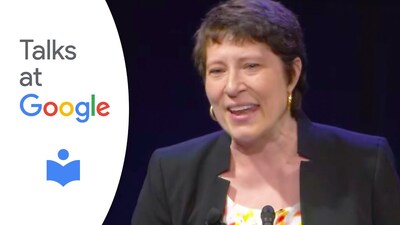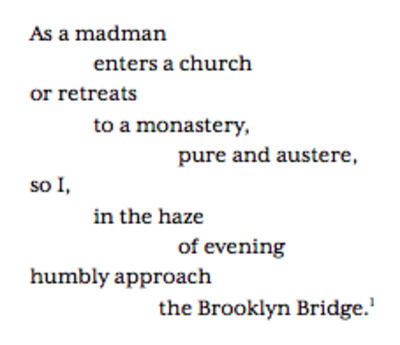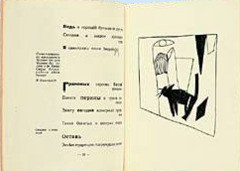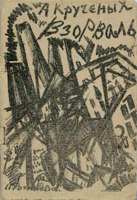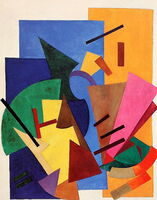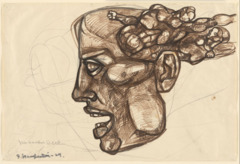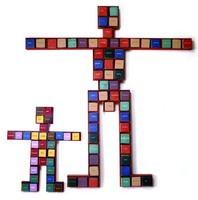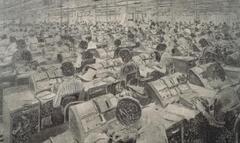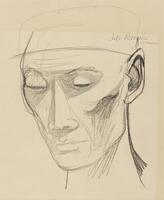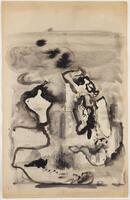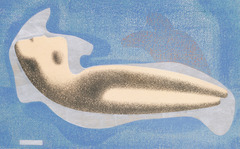Bridges: Immigration Across Two Hemispheres
a virtual exhibition for practical professional development at the university of michigan museum of art
Allison Pujol
WHY AN ART EXHIBIT?
Due to the nature of the COVID-19 pandemic, most professional development in the United States in 2020 -- and unfortunately, at least some of 2021 -- will have to be virtual. As many professionals have likely experienced these past few months, it's hard to stay engaged and focused in front of a screen. Luckily, paying close attention to artistic work can serve as an engaging and interesting form of personal development -- as well as inspire new techniques and ideas in other seemingly-unrelated fields. Educator Amy Herman attests to this in the clip to the left (the first 15 minutes are definitely worth a watch). Moreover, researchers and teachers alike have argued on behalf of the benefits of learning about art to develop empathy and creativity in children and adults. As the curator, I hope that the works in this exhibit inspire empathy, creativity and more.
This exhibit will display and celebrate art that indeed crosses two hemispheres. Works included in this exhibit have been sourced from institutions as close by as the UMMA itself and as far away as the Virtual Russian Museum based in St. Petersburg, Russia.
BACKGROUND: RUSSIA-U.S. IMMIGRATION, 1840-1950
Between 1846-1940, approximately 56-58 million Europeans immigrated to North and South America. During this time, the United States formulated its legal immigration system. Regulations and restrictions on immigration that were first adopted during the late 1800s continue to shape migration and asylum law today.
Legal restrictions on immigration in the United States have historically defined migrants and their host countries in economic terms. Caps on immigration based on national origin predominantly favored immigrants that were seen as white, wealthy and able-bodied. Immigration, many in the international and humanitarian community agreed, was beneficial for a host country as long as it was able to safeguard its economic and social status. However, some of the steps the United States took to preserve jobs for its domestic population -- including a ban on contract labor in 1885 -- made it difficult for some immigrants to secure employment overseas before arriving in the States. Despite facing challenges such as xenophobia, racism and classism upon arrival, many of the Eastern European and Russian immigrants who came to the United States during this period were also hugely responsible for imparting unique influences on the art scene in both their host and home country.
CONFLICTING ARTISTIC VISIONS
It is difficult enough to summarize one artistic school in a single label or word (ask Pablo Picasso and Olga Rozanova what "cubism" signifies and you'll get different answers) and it is nearly impossible to constrain decades of artistic work and thought across two different continents. However, there are several definitive yet contrasting artistic styles that arose in response to the massive flows of immigration from Russia to the United States from 1850-1950 and beyond.
One of these responses was Russian Futurism, an artistic movement that rejected old Russian tradition and saw America as a nearly mythically progressive and growing society that could potentially provide the inspiration necessary to resolve Russia's own social and economic problems. This approach was exemplified by artist and poet Vladimir Mayakovsky's poem "Brooklyn Bridge" (at right), which sees the namesake American architectural icon as a sacred, pure place. Additionally, Russian Futurists relied heavily on cubism (an artistic style that uses simple shapes in order to represent more complex people, places or things), the avant-garde and the abstract.
Many artists, in contrast, did not necessarily utilize their art as a vehicle to explore the wonders of early-20th century American society. Artists such as Anton Refregier and Morris Topchevsky arguably use far less abstract means to convey their own thoughts about immigration between Russia and the United States. Some artists chose to exhibit the frank xenophobic and classist realities of their new home by making art that depicted realistic scenes of immigrant life. If the Russian Futurists wanted to examine the future of a society driven by speed and mechanical progress, Expressionists and Realists wanted to examine the present society that drove some forward towards technological gains but left others out of prosperity and locked in poverty. Perhaps in truth every artist -- and their work -- intends to both look forward and backward, to look and hope for a better future while realizing the errors of the present.
All of the artists represented in this exhibit, surely, would hope for just as much. If all artistic work is intended to speak out against injustice, reveal inextinguishable truths about human nature, or summon beauty out of the mundane, then the art displayed in this exhibition, in the words of Mayakovsky, "rises to address the ages, history, and all creation."
Read the description for this exhibit below or click through the thumbnails at the bottom of the page to focus on a particular image.
For a complete list of sources consulted, exhibit URLs, or supplemental readings on this topic, please visit https://docs.google.com/document/d/1RzT4n54qwrLhxi_ZJJiBuIQmBhVSWR4kbZiZiO97NPc/edit?usp=sharing
For questions or further concerns contact ampmich@umich.edu or allison.m.pujol@gmail.com.
Morris Topchevsky likely drew on his own experience as a Polish immigrant seeking to escape anti-Semitic persecution and violence when creating his series Refugees. With his work being exhibited widely across the country during his life, Topchevsky was able to use his art to honor his own background and potentially shed light on the immigrant lives of many across the United States. |
|
| At right is another Topchevsky piece titled In a Relief Station. The contrast of the chirpy signs in the background (you can enlarge the thumbnail of the photo at the bottom of this page) of the piece with the despondent faces of the men in the pictures serves as a potential commentary about American society among different socioeconomic classes. Devoid of color and excitement, the image's color scheme undoubtedly evokes a sense of dread that clashes directly with the cheerful signs intended for the relief station's inhabitants. | |
| Russian-American muralist Anton Refregier likely completed Study of a Man's Head for "History of California" when he worked for the Works Public Administration (WPA) during the Great Depression. This particular work is an early sketch from his famous WPA mural "The History of California" located in downtown San Francisco, CA. The full mural depicts the state's history across twenty-seven separate panels, and this image is an early draft of a face from a panel depicting a group of laborers clearing a pile of large stones. | |
Not all immigrant artists felt compelled to seek out government-provided work; on the contrary, Ukrainian-American artist Robert Brackman held a long and successful career teaching at elite art schools and painting portraits for Rockefellers. Brackman's usual subjects for his paintings were white and wealthy elites or nude models, but the Black child who posed for Somewhere in America (shown at right) offered the Ukrainian-American artist a different perspective. The background of the image is simple enough; a plate of fruit sits on a red checkered cloth and suggests a normal domestic setting -- the setting is "somewhere," or really, "anywhere" in America. Perhaps the most powerful component of this painting lies in the young girl's face that stares steadily at the viewer, her eyes seeming to ask Brackman (and us), "What are you looking at?" |
|
|
Vladimir Mayakovsky's A Tragedy in Two Acts with a Prologue and an Epilogue was published by the First Journal of Russian Futurists in Moscow, Russia in 1914. Featuring artwork from well-known Russian Futurists Vladimir Burliuk and David Burliuk, A Tragedy exemplifies the communal art that was typical of Russian Futurists at the time. Mayakovsky later went on to create more works as a leader of the Russian Futurist artistic movement along with the Burliuks and Olga Rozanova. |
|
| Russian artist Olga Rozanova also kept company with many Russian Futurists and often contributed artistically to the covers of their zines or other works. This zine cover, Explodity, shows some of her early commitment to cubism and abstract expression. It's unclear what the shapes might represent in the context of the title of her work - perhaps a building, a collection of debris, or something else entirely. | |
| Rozanova's work above bears some stylistic similarities to her more well-known piece, Non-Objective Composition (Flight of an Airplane), shown at left. Completed only five years after her work on the Russian Futurist zine shown above, Non-Objective Composition shows remarkable growth and innovation as an artist. The piece currently resides at the Samara Regional Museum of Fine Arts in Samara, Russia. | |
|
Nearly a hundred years after his early works as an abstract expressionist, Mark Rothko has emerged as some sort of household name in the U.S. Born as Marcus Rothkowitz in present-day Latvia, Rothko immigrated to the United States with his family when he was a young child. Later in life he would attend Yale, planning to become an attorney or an engineer, but other more artistic vocations eventually won him over. Rothko certainly wouldn't be happy with any attempt to explain his work on his behalf -- the artist was generally tight-lipped about the meaning of his creations, believing that abstract art should be able to speak for itself. What he likely would say, though, is that abstract art like that depicted in this early untitled work is far more captivating and interesting than landscapes (which Rothko absolutely protested and refused to draw). |
|
| Ukrainian-American sculptor Alexandr Archipenko is understood as a leader in bringing cubism to architecture and sculpture. His piece at left Torso in Space honors cubism by using abstract geometric shapes to depict the human body -- a technique that he used throughout most of his sculpture pieces. This particular piece is one of his most acclaimed works. | |
|
Russian-American artist Ernst Niezvestny was once described by playwright Arthur Miller as "the philosophical conscience of his country" and by author Harrison Salisbury as the "one of the great artistic talents of the twentieth century." Not everyone had such high praise for the artist, however. "Why do you disfigure the faces of our nation?" Nikita Kruschev reportedly complained of Ernst Niezvestny's work. I like to think that Nieznvestny got the last laugh; the sculptor was later approached by Kruschev family to design the late Soviet leader's tomb after he died. |
|
| Rimma Gerlovina and Valeriy Gerlovin's work Interchangeable People makes abstract art quite literally come alive. The Russian-American couple's piece is composed of individual soft, fleshy six-sided cubes put together to compose human-like shapes. Each side of the cubes has a different word written -- for example, "rational", "queer", "abnormal" or "normal" -- and viewers in the exhibit can re-arrange the cubes to compose a person made of different characteristics. The artwork suggests that people are as malleable as the exhibit itself and are in a constant state of flux and growth. |
|
| Born in an Eastern European immigrant family, Richard Artschwager showed a love for the arts at an early age. After majoring in physics in college, a stint in the United States Army in World War II, and a few other odd jobs, Artschwager returned to pursue the arts as an adult in the late 1940s (nearly twenty years before creating ICS - Computer Center). The image shown at right is an anomaly within Artschwager's portfolio of work; although Artschwager worked as an abstract expressionist painter for much of his early years as a developing artist, he's more known for his work with sculpture. | |
|
Igor Tulipanov's Being Flowers is potentially the most ambitious of all the pieces in this exhibit: arguably, the piece contains elements of cubism, expressionism and surrealism (the expression of the unconscious through the juxtaposition of illogical or unusual images). Born in St. Petersburg, Russia in 1939, Tulipanov is also one of the younger artists in this collection. The artist's surrealist work often provokes considerations about whether the art we see is more real than the things we experience every day. Being Flowers depicts a human face hidden among a cluster of brightly-colored flowers, asking questions about who we are as human beings and where we have yet to go. |
0 Tags & 3 Keywords
Tags
Created For
K-12 EducatorK-12 Student
Museum Visitor
UMMA Docent
UMMA Staff
University Faculty
University Student
Rate this Resource
AVG: 0 | Ratings: 0
& Author Notes
All Rights Reserved (Work on this exhibit was made possible through a grant from the U.S.-Russia Foundation to the Ford School of Public Policy and the Center for Russian, East European & Eurasian Studies (CREES) at the University of Michigan.)
Last Updated
September 1, 2020 3:27 p.m.Report
Reporting Policy
